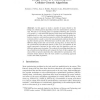Free Online Productivity Tools
i2Speak
i2Symbol
i2OCR
iTex2Img
iWeb2Print
iWeb2Shot
i2Type
iPdf2Split
iPdf2Merge
i2Bopomofo
i2Arabic
i2Style
i2Image
i2PDF
iLatex2Rtf
Sci2ools
EMO
2006
Springer
2006
Springer
Design Issues in a Multiobjective Cellular Genetic Algorithm
In this paper we study a number of issues related to the design of a cellular genetic algorithm (cGA) for multiobjective optimization. We take as an starting point an algorithm following the canonical cGA model, i.e., each individual interacts with those ones belonging to its neighborhood, so that a new individual is obtained using the typical selection, crossover, and mutation operators within this neighborhood. An external archive is used to store the non-dominated solutions found during the evolution process. With this basic model in mind, there are many different design issues that can be faced. Among them, we focus here on the synchronous/asynchronous feature of the cGA, the feedback of the search experience contained in the archive into the algorithm, and two different replacement strategies. We evaluate the resulting algorithms using a benchmark of problems and compare the best of them against two state-of-the-art genetic algorithms for multiobjective optimization. The obtained ...
Related Content
| Added | 22 Aug 2010 |
| Updated | 22 Aug 2010 |
| Type | Conference |
| Year | 2006 |
| Where | EMO |
| Authors | Antonio J. Nebro, Juan José Durillo, Francisco Luna, Bernabé Dorronsoro, Enrique Alba |
Comments (0)

